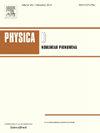Two-dimensional quantum droplets in quadrupolar Bose–Einstein condensates
IF 2.9
3区 数学
Q1 MATHEMATICS, APPLIED
引用次数: 0
Abstract
The discovery of stable quantum droplets in dipolar Bose–Einstein condensates has spurred interest in exploring their existence in other polar Bose–Einstein condensates systems. Among these, quadrupolar Bose–Einstein condensates—known for their unique anisotropic interactions—hold strong potential for the emergence of quantum droplets. In this study, we investigate the existence and stability of two-dimensional quantum droplets in systems with electric quadrupole–quadrupole interactions, supplemented by Lee–Huang–Yang quantum corrections. These systems exhibit anisotropic behavior, with droplets that elongate along the polarization axis due to the interplay of quadrupolar interactions and quantum fluctuations, as described by a two-dimensional extended Gross–Pitaevskii equation. Using theoretical analysis and numerical simulations, we demonstrate the stable existence of both fundamental and vortex quantum droplets (with topological charge ). Key parameters such as peak density, chemical potential, and effective area are examined to elucidate the characteristics of these quantum droplets. Furthermore, we examine collision dynamics under both transverse and longitudinal configurations, shedding light on the anisotropic nature of droplet interactions. These findings pave the way for experimental realization and enrich the theoretical understanding of quantum droplets in quadrupolar Bose–Einstein condensates.
四极玻色-爱因斯坦凝聚体中的二维量子液滴
偶极玻色-爱因斯坦凝聚体中稳定量子液滴的发现激发了人们探索它们在其他极性玻色-爱因斯坦凝聚体中存在的兴趣。其中,四极玻色-爱因斯坦凝聚态——以其独特的各向异性相互作用而闻名——对量子液滴的出现具有很强的潜力。在这项研究中,我们研究了二维量子液滴在电四极-四极相互作用系统中的存在性和稳定性,并辅以Lee-Huang-Yang量子修正。这些系统表现出各向异性的行为,由于四极相互作用和量子涨落的相互作用,液滴沿着极化轴拉长,正如二维扩展的Gross-Pitaevskii方程所描述的那样。通过理论分析和数值模拟,我们证明了基本量子液滴和涡旋量子液滴(拓扑电荷S=1)的稳定存在。研究了峰密度、化学势和有效面积等关键参数来阐明这些量子液滴的特性。此外,我们研究了横向和纵向结构下的碰撞动力学,揭示了液滴相互作用的各向异性。这些发现为实验实现铺平了道路,丰富了四极玻色-爱因斯坦凝聚体中量子液滴的理论认识。
本文章由计算机程序翻译,如有差异,请以英文原文为准。
求助全文
约1分钟内获得全文
求助全文
来源期刊

Physica D: Nonlinear Phenomena
物理-物理:数学物理
CiteScore
7.30
自引率
7.50%
发文量
213
审稿时长
65 days
期刊介绍:
Physica D (Nonlinear Phenomena) publishes research and review articles reporting on experimental and theoretical works, techniques and ideas that advance the understanding of nonlinear phenomena. Topics encompass wave motion in physical, chemical and biological systems; physical or biological phenomena governed by nonlinear field equations, including hydrodynamics and turbulence; pattern formation and cooperative phenomena; instability, bifurcations, chaos, and space-time disorder; integrable/Hamiltonian systems; asymptotic analysis and, more generally, mathematical methods for nonlinear systems.
 求助内容:
求助内容: 应助结果提醒方式:
应助结果提醒方式:


